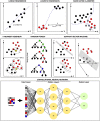Artificial Intelligence and Machine Learning in Pathology: The Present Landscape of Supervised Methods
- PMID: 31523704
- PMCID: PMC6727099
- DOI: 10.1177/2374289519873088
Artificial Intelligence and Machine Learning in Pathology: The Present Landscape of Supervised Methods
Abstract
Increased interest in the opportunities provided by artificial intelligence and machine learning has spawned a new field of health-care research. The new tools under development are targeting many aspects of medical practice, including changes to the practice of pathology and laboratory medicine. Optimal design in these powerful tools requires cross-disciplinary literacy, including basic knowledge and understanding of critical concepts that have traditionally been unfamiliar to pathologists and laboratorians. This review provides definitions and basic knowledge of machine learning categories (supervised, unsupervised, and reinforcement learning), introduces the underlying concept of the bias-variance trade-off as an important foundation in supervised machine learning, and discusses approaches to the supervised machine learning study design along with an overview and description of common supervised machine learning algorithms (linear regression, logistic regression, Naive Bayes, k-nearest neighbor, support vector machine, random forest, convolutional neural networks).
Keywords: algorithms; artificial intelligence; convolutional neural network; deep learning; k-nearest neighbor; machine learning; random forest; supervised learning; supervised methods; support vector machine; unsupervised learning.
Conflict of interest statement
Declaration of Conflicting Interests: The author(s) declared no potential conflicts of interest with respect to the research, authorship, and/or publication of this article.
Figures





References
-
- EMC Digital Universe. IDC Vertical Industry Brief. The digital universe driving data growth in health care; challenges and opportunities for it 2014. Vertical Industry Brief https://www.emc.com/analyst-report/digital-universe-healthcare-vertical-....Accessed December 29, 2015.
-
- Samuel AL. Some studies in machine learning using the game of checkers. IBM J Res Dev. 1959;3:210–229.
-
- Koza JR, Bennett FH, III, Andre D, Keane MA. Automated design of both the topology and sizing of analog electrical circuits using genetic programming In: Gero JS, Fay S, eds. Artificial Intelligence in Design ‘96. Berlin, Germany: Springer; 1996:151–170.
-
- The Center for Devices and Radiological Health (CDRH). Proposed Regulatory Framework for Modifications to Artificial Intelligence/Machine Learning (AI/ML)-Based Software as a Medical Device (SaMD)—Discussion Paper and Request for Feedback. In: Food and Drug Administration (FDA) 2019.
-
- Becich MJ. Information management: moving from test results to clinical information. Clin Leadersh Manag Rev. 2000;14:296–300. - PubMed

